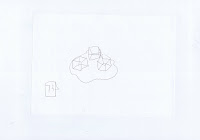This "infographic" has come about in a time when fat has (nearly) ceased been blamed for causing the plague of obesity and heart disease and sugar has become "the new tobacco." In this big turn-around of health science dogma, the main culprit is high fructose corn syrup, a sugar substitute made from corn that has been replacing real sugar in soft drinks in a number of places since the 1970s. Because of this the increasing consumption of soft drinks over the years has been considered by many as a big contributor towards the plight of the westernised person. This is the main point of this "infographic." We are drinking too much soda and we should cut down.
And if you are considering doing so by switching to "diet" sodas, guess what..... Just recently (due to recent command from readers due to the "infographic's" recent popularity) Niraj made a squeal about what happens when you drink a can of diet coke. To sum up, not only it has similar effects as regular coke, the artificial sweeteners also do something very alarming.... they'll make you eat more! I have known about this for years (which is why (if I had the choice) I prefer the regular kind over the diet or low-calorie versions of soft drinks).
The brain isn't that fooled by the sweeteners. When it receives the taste signals from to tongue it notices the lack of sugar in your system, due to the ancient program of "sweet taste = energy."
When confronted with this situation the brain subconsciously programs you to seek out food to compensate the supposed "missing fuel."
As a result of this, people who drink diet sodas tend to eat more than people who drink regular sodas, which kind of defeats the point of them in the first place.
And this isn't me just speculating. This observation has been noted for years now.
With this in mind dear readers I advise that if you are on a diet avoid artificial sweeteners,
especially in the form of diet sodas.
(Please not that I am not a qualified professional in the field of medicine, health or nutrition.
I am an artist with an interest in everything, including the cult of improving one's health.)
I am an artist with an interest in everything, including the cult of improving one's health.)
On that final note, the real reason for this post. Been a trained graphics designer, looking at this "infographic" I have to admit.... it is dull! It isn't exactly eye-grabbing. It's just a picture of a can of coke with a column of text on each side. To someone like me, it doesn't deserve to be called an "infographic." But it is understandable why. Niraj was a pharmacist. He couldn't have had the ability to design a better graphic worthy of been called an infographic. Have you seen behind the counter in a pharmacy? It isn't a graphically-stimulating environment.... and that kind of shows in this "infographic."
The diet coke one has some improvement, with a quote in a highlighted box and the can been given a large backside. Apart from that, its still the same boring "infographic."
So (for his sake) I decided to give it this re-design....
Technically, this shouldn't be seen as part of my series of "informative strips" because I didn't research it personally and write the text. I just copy and pasted the text from the original graphic. I only drew the illustrations and positioned the text (nothing else). If you have any complaints about the content of the text tell them to Niraj, NOT ME!
And Niraj, if you are reading this and want to use it, feel free to do so.
















































































